Abschnitt 4 - 4 Glossary
| Acoustic quality | The acoustic quality of an office describes its suitability for various forms of communication. |
|---|---|
| Colour rendering index | The colour rendering index (Ra) is a dimensionless value expressing how colours in the light generated by a lamp are reproduced. The higher the value, the more faithful the colour reproduction. |
| Context of use | EN ISO 9241-11 employs the term "context of use" to describe the overall relationship between users, tasks and the associated equipment (hardware, software and materials). The context of use is also influenced by the physical and social environment in which equipment is used or tasks are performed. |
| Daily noise exposure level | The daily noise exposure level is the noise exposure level averaged over a day, an eight-hour shift. It encompasses all sound events occurring at the workplace. |
| Designated screen illuminance | The designated screen illuminance is a value defined by the German Social Accident Insurance for the maximum permissible illuminance on the screen caused by the ambient lighting. |
| Displacement volume | The displacement volume of a floor covering is the cavity beneath the walking plane and open to it that absorbs or dissipates slippery substances. |
| Emotional demands upon employees | Emotional demands are made upon employees when the work process generates an emotional response and the investment of effort and energy generates positive or negative feelings or moods (such as annoyance or gratification). |
| Emotional labour | Personal work with third parties (e.g. customers, clients, patients) may require employees to intensify, attenuate or modify their own emotions and those of third parties. The aim of emotional labour is for employees to communicate for example with angry or bad-tempered customers soberly and thereby (1) to suppress inappropriate emotions of their own as they arise, (2) to interact with third parties such that negative emotions do not arise in the first instance (for example "always smile", "de-escalate") and (3) to interact with third parties such that the latter's negative emotions (annoyance, anger, sadness) are not only attenuated, but converted into positive emotions (gratification, enthusiasm), for example in order to enhance customer loyalty. Emotional labour may lead to impairments (such as mental satiation, stress) that can be reduce by a change in task, additional breaks, training and supervision. |
| Free user area | Free user areas in offices are unobstructed floor areas at workstations and in meeting areas, or individual items of furniture. They constitute the minimum requirement for the user to perform the task concerned functionally and properly. |
| LED | LED stands for light-emitting diode. LEDs are semiconductor components that light up when current flows through them. |
| Legroom | Legroom is the unobstructed area beneath a desk that is available for the legs and feet. |
| Legibility | Legibility is a dimension for the recognizability of text and characters. A text with good legibility can be read quickly and without error. The legibility is related directly to the design of characters, lines, contrasts and surfaces. |
| Luminance L | Luminance is the luminous intensity per unit area. It can be stated in candelas per square metre (cd/m2). |
| Mental satiation | Mental satiation is a state of nervously unsettled, strongly emotional rejection of a repetitive task or situation in which the experience is of "marking time" or "not getting anywhere" (EN ISO 10075-1). When frequently repeated, a task initially experienced as pleasant or neutral loses its characteristic of being positively challenging for the person performing it. A pronounced aversion to this task then arises. In her study of mental satiation, the Finnish psychologist Anitra Karsten states that "the satiation is frequently so strong that in spite of the most rapt attention, good will, and effort the subject can no longer correctly perform the task". |
| Non-slip properties | The non-slip properties of a floor surface are those that effectively prevent a person from slipping on it. |
| Occupational medical care upon request | Under Section 11 of the German occupational health and safety act (ArbSchG) and Section 5 a of the German ordinance on preventive occupational medical care (ArbMedVV), the employer is obliged to provide the employee at the latter's request with regular occupational medical consultations and checkups. A right to occupational medical care upon request does not exist when the risk assessment and the protective measures taken indicate that no harm to health need be anticipated. |
| Psychosocial (working) conditions | Psychosocial conditions refer to mental factors (perception, thinking, action, feelings) in a social context (i.e. fair distribution of tasks within a working group; expectations of work performance are governed by standards within working groups). |
| Reverberation time | The reverberation time is the time taken for the sound pressure level to fall by 60 dB, for example after a loud noise. |
| Sans-serif font | The font used here is a sans-serif font, since it lacks concluding strokes at the end of letters. Conversely, this sentence employs a serif font. |
| Skilled electrician | A person whose training, knowledge and experience and familiarity with the relevant regulations enable him or her to assess and perform electrical work to which he or she has been assigned. |
| Sound assessment level | The sound assessment level is the value of the sound pressure level of the sound events arising at a workplace or during a task, averaged over a specified period of time (such as an hour or a working day). |
| Translucent areas | Translucent areas are areas of windows, doors, walls or skylights made of glass, plastic or other materials through which light can pass. |
| UGR value | UGR stands for unified glare rating. The UGR value is an arithmetic dimensionless value that expresses the level of psychological glare caused by a lighting installation for a defined observer in an indoor space. |
| Workplace | Workplaces are:
|
| Workplace health management | Workplace health management encompasses the systematic development and control of company structures and processes with the objective of using the health-conscious design of work and organization and the equipping of individuals to behave in a health-conscious manner in order to retain and enhance employees' health and performance. |
| Workplace health promotion | Workplace health promotion encompasses all measures taken by a company for the purpose of enhancing health literacy and generating conditions and behaviour conducive to good health, in order to improve the employees' health and well being. These measures also include discrete measures of limited duration. |
Minimum requirements for VDU workplaces (overview)
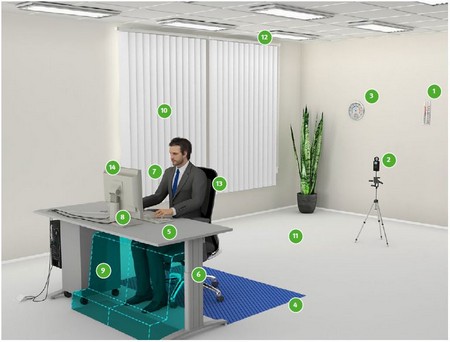
 | Temperature (20 °C -22 °C) |
|---|---|
 | Air velocity (max. 0,15 m/s) |
 | Relative atmospheric humidity (max. 50 %) |
 | Free movement area (at least 1.5 m2 and at least 1 m deep and wide |
 | Desk dimensions (at least 160 × 80 cm) |
 | Desk height (at least 74 ± 2 cm; preferably fully height-adjustable) |
 | Viewing distance (at least 50 cm) |
 | Screen height (as low as possible; topmost line no higher than eye level) |
 | Legroom (legroom as shown in the image at least 85 cm; preferably 120 cm or greater) |
 | Position of the screen with respect to the glazed wall (direction of view parallel to the glazed wall) |
 | Acoustics (55 dB(A) - 70 dB(A), reverberation time between 0.5 and 0.8 s) |
 | Lighting (500 lux - 750 lux; colour reproduction) |
 | Chair for office work |
 | Suitable reflectance values (0.15 to 0.75) |
Links and further literature
Risk assessment
Practical support and assistance in performance of a risk assessment in office companies can be found at www.gefaehrdungsbeurteilung.de (a resource of the Federal Institute for Occupational Safety and Health, BAuA)
Resources for instruction
All media presented here are available for download free of charge at www.vbg.de.
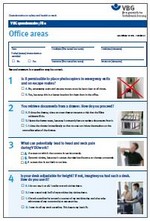 VBG (eds.): VBG-Fragebogen Bürobereich, FB 6 (questionnaire for safety and health at work). Resources for the provision of instruction to office employees.
VBG (eds.): VBG-Fragebogen Bürobereich, FB 6 (questionnaire for safety and health at work). Resources for the provision of instruction to office employees.
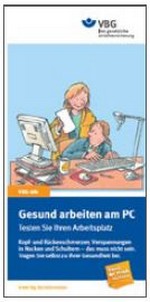 VBG (eds.): VBG-Info; Gesund arbeiten am PC. Testen Sie Ihren Arbeitsplatz (Version
2.1/2016-01), Hamburg. Leaflet for the provision of instruction at VDU workplaces;
with information on the placement and arrangement of work equipment on the desk and
correct adjustment of desk and chair.
VBG (eds.): VBG-Info; Gesund arbeiten am PC. Testen Sie Ihren Arbeitsplatz (Version
2.1/2016-01), Hamburg. Leaflet for the provision of instruction at VDU workplaces;
with information on the placement and arrangement of work equipment on the desk and
correct adjustment of desk and chair.
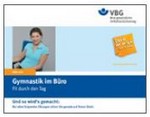 VBG (eds.): VBG-Info; Gymnastik im Büro. Fit durch den Tag (Version 1.1/2010-12), Hamburg. Leaflet for promoting exercise in offices. With numerous instructions for exercises that can be performed on the chair at the workplace or in the break room.
VBG (eds.): VBG-Info; Gymnastik im Büro. Fit durch den Tag (Version 1.1/2010-12), Hamburg. Leaflet for promoting exercise in offices. With numerous instructions for exercises that can be performed on the chair at the workplace or in the break room.
Practical aids
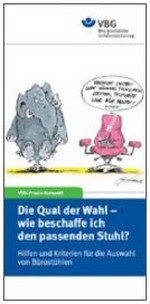 VBG (eds.): VBG-Praxis-Kompakt; Die Qual der Wahl - wie beschaffe ich den passenden
Stuhl? (Version 1.2/2015-03), Hamburg. Compact informative document providing assistance
in selecting and purchasing suitable office chairs.
VBG (eds.): VBG-Praxis-Kompakt; Die Qual der Wahl - wie beschaffe ich den passenden
Stuhl? (Version 1.2/2015-03), Hamburg. Compact informative document providing assistance
in selecting and purchasing suitable office chairs.
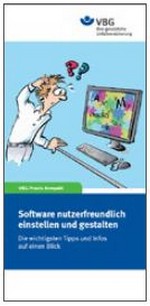 VBG (eds.): VBG-Praxis-Kompakt; Software nutzerfreundlich einstellen und gestalten
(Version 2.4/2016-11), Hamburg. Informative document with practical tips on software
ergonomics and advice on using and designing software
VBG (eds.): VBG-Praxis-Kompakt; Software nutzerfreundlich einstellen und gestalten
(Version 2.4/2016-11), Hamburg. Informative document with practical tips on software
ergonomics and advice on using and designing software
Links to further sector-specific information
Website of the German Trade Union Federation (DGB)
Website of the Confederation of German Employers' Associations
Website of the Federal institute for Occupational Safety and Health (BAuA)
Website of the German Social Accident Insurance (DGUV)
Website of the German Social Accident Insurance Institution for the administrative sector (VBG)
Website of the German United Services Trade Union (ver.di)

